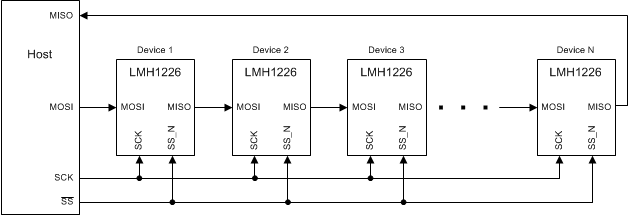JAJSFL6D April 2016 – June 2018 LMH1226
PRODUCTION DATA.
- 1 特長
- 2 アプリケーション
- 3 概要
- 4 改訂履歴
- 5 Pin Configuration and Functions
- 6 Specifications
-
7 Detailed Description
- 7.1 Overview
- 7.2 Functional Block Diagram
- 7.3
Feature Description
- 7.3.1 4-Level Input Configuration Pins
- 7.3.2 Input Carrier Detect
- 7.3.3 Continuous Time Linear Equalizer (CTLE)
- 7.3.4 Input-Output Mux Selection
- 7.3.5 Clock and Data Recovery (CDR) Reclocker
- 7.3.6 Internal Eye Opening Monitor (EOM)
- 7.3.7 Output Function Control
- 7.3.8 Output Driver Amplitude and De-Emphasis Control
- 7.3.9 Status Indicators and Interrupts
- 7.4 Device Functional Modes
- 7.5 LMH1226 Register Map
- 8 Application and Implementation
- 9 Power Supply Recommendations
- 10Layout
- 11デバイスおよびドキュメントのサポート
- 12メカニカル、パッケージ、および注文情報
パッケージ・オプション
メカニカル・データ(パッケージ|ピン)
- RTW|24
サーマルパッド・メカニカル・データ
- RTW|24
発注情報
7.4.2.2 SPI Daisy Chain
The LMH1226 supports SPI daisy-chaining among multiple devices, as shown in Figure 20.
 Figure 20. Daisy-Chain Configuration
Figure 20. Daisy-Chain Configuration Each LMH1226 device is directly connected to the SCK and SS_N pins of the host. The first LMH1226 device in the chain is connected to the host’s MOSI pin, and the last device in the chain is connected to the host’s MISO pin. The MOSI pin of each intermediate LMH1226 device in the chain is connected to the MISO pin of the previous LMH1226 device, thereby creating a serial shift register. In a daisy-chain configuration of N x LMH1226 devices, the host conceptually sees a shift register of length 17 x N for a basic SPI transaction, during which SS_N is asserted low for 17 x N clock cycles.